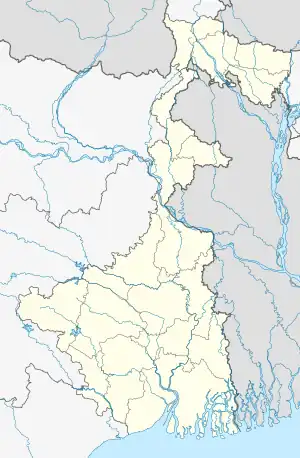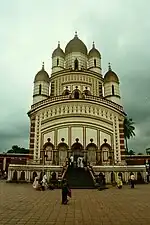| Baneswar Shiva Temple | |
|---|---|
বাণেশ্বর মন্দির | |
 Picture: Baneswar Temple | |
| Religion | |
| Affiliation | Hinduism |
| Festivals | Shivratri |
| Location | |
| Location | Baneswar |
| State | West Bengal |
| Country | India |
 Shown within West Bengal  Baneswar Shiva temple (India) | |
| Geographic coordinates | 26°23′57″N 89°29′51″E / 26.399063°N 89.497535°E |
Baneswar Shiva temple is at Baneswar in the Cooch Behar II CD block in the Cooch Behar Sadar subdivision of the Cooch Behar district in West Bengal, India.
Geography
CT: census town, M: municipal town, R: rural/ urban centre, H: historical/ religious centre
Owing to space constraints in the small map, the actual locations in a larger map may vary slightly
Location
Baneswar Shiva temple is located at 26°23′57″N 89°29′51″E / 26.399063°N 89.497535°E.
It is about 10 kilometres (6.2 mi) from Cooch Behar and is located near Baneswar railway station on the Alipurduar-Bamanhat branch line. It is 1.6 kilometres (0.99 mi) from New Baneswar railway station on the New Jalpaiguri–New Bongaigaon section of the Barauni–Guwahati line.[1][2][3]
Note: The map alongside presents some of the notable locations in the subdivision. All places marked in the map are linked in the larger full screen map.
The temple
The beginning of Baneswar Shiva temple is mired in mythology. According to popular belief the legendary Raja Banasura, an ardent devotee of Shiva had made the latter agree to come down to earth. When Shiva was following Raja Banasura, the latter suddenly stopped at Baneswar (earlier name Gordasandara), which was a breach of agreement. Shiva instantly disappeared and later established a Shiva-linga on the banks of the Bangti River. Many believe that the place was named after the Raja. However, there is no mention of the temple in the legend.[1]
According to some, the temple was built by Raja Jalpeswar, who built the Jalpesh temple. He is believed to have ruled in the second or third century and is mentioned in ‘Jalpesh Mahatya’. Some others think that Raja Nilambar of the Khen dynasty had built it. Yet others think that Maharaja Nara Narayan of the Koch dynasty established it and Maharaja Pran Narayan of the Cooch Behar State subsequently revamped it.[1]
The present structure is squarish with a dome and a slightly curved cornish. It has two entrances -one on the west and the other in the east. The temple has a Shiva linga and a ‘Gouripat’ in the garbhagriha, 3.1 metres (10 ft) below the plinth level. The temple was slightly tilted on the east during an earth-quake in 1897. It has a height of 10.9 metres (36 ft) and the base measures 9.6 metres (31 ft) square. The walls are 2.5 metres (8 ft 2 in) thick. There are some decorated narrow strips on the walls. It has a raised platform in the front. There is a bull made of cement on the right. On the northern side there is a tin shed housing idols of Shiva and ‘ardhanariswar’. There are some other idols also, including a Kali idol in another shed.
There is a big pond nearby 'Shiv pukur' which is a habitat of many Black softshell turtle, a critically endangered species of turtle. The turtles are locally known as 'Mohan' and are sacred.
A week-long fair is held during Shiva Chaturdashi. This temple is under the Cooch Behar Debuttor Sangstha.[1][4]
Baneswar Shiva temple is a state protected monument.[5]
Baneswar Shiva temple picture gallery
References
- 1 2 3 4 Koch Bihar Jelar Purakirti (in Bengali), Data compilation and writing by Dr. Shyamachand Mukhopadhayay, published by the Department of Archaeology, Government of West Bengal, Second edition 1974, Pages 52-56.
- ↑ "55765 =>55465 Alipurduar – Bamunhat Passenger". Time Table. Indiarailinfo. Retrieved 31 July 2020.
- ↑ "Rangiya New Jalpaiguri Express". Time Table. IndiaRailInfo. Retrieved 10 August 2020.
- ↑ "Tourist attractions". Baneswar Siva temple. Cooch Behar district administration. Retrieved 11 August 2020.
- ↑ List of State Protected Monuments as reported by the Archaeological Survey of India Archived 2013-05-23 at the Wayback Machine.



